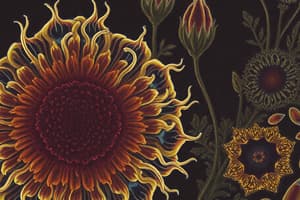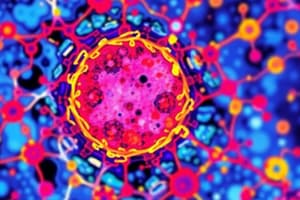Podcast
Questions and Answers
What is the primary role of cells according to the Cell Theory?
What is the primary role of cells according to the Cell Theory?
- They act as the building blocks of life. (correct)
- They are involved in genetic mutations.
- They are responsible for energy production.
- They regulate body temperature.
Which statement is true regarding prokaryotic organisms?
Which statement is true regarding prokaryotic organisms?
- They are larger than eukaryotic cells.
- They are only found in multicellular organisms.
- They have a nucleus that houses their genetic material.
- They lack membrane-bound organelles. (correct)
Which of the following statements is NOT a tenet of Cell Theory?
Which of the following statements is NOT a tenet of Cell Theory?
- All living organisms are composed of cells.
- Cells arise only from pre-existing cells.
- Cells are capable of spontaneous generation. (correct)
- The cell is the basic unit of life.
What distinguishes eukaryotic cells from prokaryotic cells?
What distinguishes eukaryotic cells from prokaryotic cells?
Which of the following correctly describes specialized structures in cells?
Which of the following correctly describes specialized structures in cells?
Flashcards
Cell Theory
Cell Theory
The idea that all living things are made up of one or more cells, and that all cells come from pre-existing cells.
What is a cell?
What is a cell?
A small, membrane-bound unit that forms the fundamental structural and functional unit of all living organisms.
Prokaryotes
Prokaryotes
Organisms, such as bacteria and archaea, that lack a nucleus and other membrane-bound organelles.
Eukaryotes
Eukaryotes
Signup and view all the flashcards
What are organelles?
What are organelles?
Signup and view all the flashcards
Study Notes
The Cell Theory Overview
- The Cell Theory is a fundamental biological concept that explains the structure and function of cells as the building blocks of life.
Key Contributors to the Cell Theory
- Robert Hooke (1665):
- Coined the term "cell" after observing cork cells under a microscope.
- Noted room-like structures, calling them "cellulae" (Latin for small rooms).
- Anton van Leeuwenhoek:
- Known as the Father of Microscopy.
- First to observe living cells and microorganisms (later identified as bacteria).
- Robert Brown (1831):
- Discovered the nucleus while studying plant cells.
- Observed pollen movement within the nucleus.
- Mathias Schleiden (1838):
- Proposed that cells are the basic unit of life in plants.
- Studied plant cells extensively under a microscope.
- Theodor Schwann (1839):
- Extended Schleiden's hypothesis to animals, stating that animal tissues are composed of cells.
- Rudolf Virchow (1858):
- Contrasted the concept of spontaneous generation with the idea that all cells arise from pre-existing cells ("Omnis cellula e cellula").
- Studied cell division and its role in disease.
The Six Tenets of Cell Theory
- Cells are the basic unit of life. The smallest units that can perform life processes.
- All living things are made of cells. From simple bacteria to complex organisms.
- All cells come from pre-existing cells. Cells reproduce via cell division.
Domains of Life
- Three Domains: Bacteria, Archaea, and Eukarya.
- Bacteria and Archaea are prokaryotes (single-celled, no nucleus).
- Eukarya includes eukaryotes (multicellular, containing a nucleus) including yeasts and algae.
Prokaryotes
- Lacks a nucleus and membrane-bound organelles.
- Important Structures:
- Pili: Hair-like attachments for movement and adhesion.
- Plasmid: Circular DNA distinct from chromosomal DNA.
- Ribosomes: Protein synthesis.
- Cytoplasm: The jelly-like substance containing cellular components.
- Cell membrane: Selectively permeable to control the passage of materials.
- Cell Wall: Provides structure and protection.
- Capsule: Helps retain moisture and protects from drying.
Eukaryotes
- Contains a nucleus and membrane-bound organelles.
- Important Organelles:
- Nucleus: Contains genetic material and controls cellular processes.
- Endoplasmic Reticulum: Transports materials within the cell.
- Golgi Apparatus: Packages and processes cellular products.
- Mitochondria: Generates energy (ATP).
- Vacuoles: Storage compartments.
- Lysosomes: Contain enzymes for digestion.
- Centrioles: Involved in cell division.
Specialized Structures
- Animal Cells:
- Cytoskeleton: Maintains shape and facilitates movement.
- Centrioles: Involved in cell division.
- Plant Cells:
- Cell Wall: Provides structure and protection.
- Chloroplasts: Site of photosynthesis.
- Central Vacuole: Stores substances like sugars, salts, and amino acids.
Studying That Suits You
Use AI to generate personalized quizzes and flashcards to suit your learning preferences.




